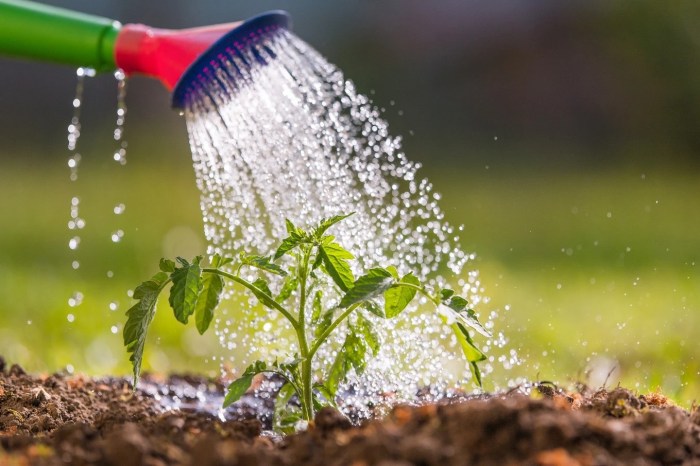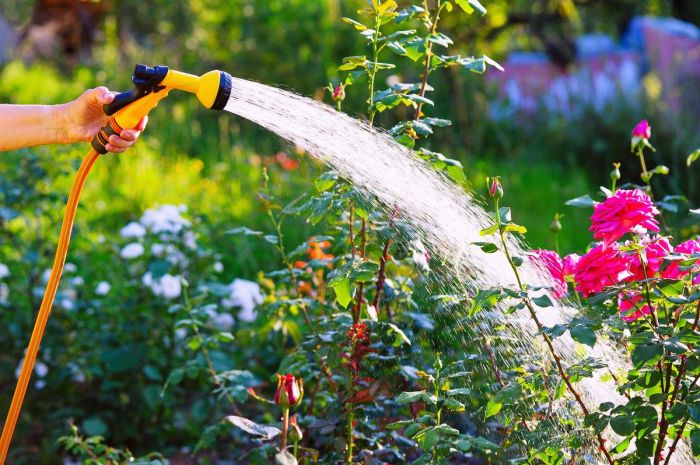What Does a Plant Use Water For?
Plant Water Uptake
What dose a plant the use water for – Plants require a constant supply of water for various essential functions. The process of water absorption begins in the roots and involves several intricate mechanisms to ensure efficient transport throughout the plant.
Water Absorption from Soil into Plant Roots
Water absorption primarily occurs through the root hairs, tiny extensions of root epidermal cells that significantly increase the surface area for contact with soil water. These root hairs are in close proximity to soil particles, facilitating the uptake of water molecules. The process is driven by the water potential gradient between the soil and the root cells, with water moving from a higher water potential (in the soil) to a lower water potential (in the root cells).
The Role of Root Hairs in Water Absorption
Root hairs are crucial for efficient water absorption due to their large collective surface area. This extensive surface area maximizes contact with soil water, allowing for greater uptake. Their thin cell walls also facilitate the rapid passage of water molecules.
Mechanisms of Water Transport in Plants

Source: atami.com
Several mechanisms contribute to water transport within plants. Osmosis, the movement of water across a semi-permeable membrane from a region of high water potential to a region of low water potential, is a primary driver. Capillary action, the ability of water to move against gravity in narrow tubes, also plays a role, particularly in the xylem vessels. Furthermore, root pressure, generated by active ion uptake in the roots, contributes to water movement upwards.
Comparison of Water Uptake Mechanisms in Different Plant Types
Different plant types exhibit variations in their water uptake strategies, adapted to their specific environments.
| Plant Type | Root System | Primary Uptake Mechanism | Adaptations |
|---|---|---|---|
| Herbaceous Plants | Fibrous, shallow | Osmosis, capillary action | Rapid water uptake, sensitive to drought |
| Woody Plants | Extensive, deep | Osmosis, capillary action, root pressure | Efficient water storage, drought tolerance |
| Desert Plants | Deep, extensive, or specialized | Osmosis, capillary action, specialized tissues | Water storage, reduced transpiration |
| Aquatic Plants | Reduced or absent | Direct absorption through leaves/stems | Specialized tissues for gas exchange |
Photosynthesis and Water
Water plays a vital role in photosynthesis, the process by which plants convert light energy into chemical energy in the form of sugars. This process is essential for plant growth and survival.
The Role of Water in Photosynthesis
Water serves as an electron donor in the light-dependent reactions of photosynthesis. During this process, water molecules are split (photolysis), releasing electrons that are used to replace those lost by chlorophyll molecules in photosystem II. This electron transfer chain generates ATP and NADPH, which are crucial for the subsequent light-independent reactions (Calvin cycle).
Water’s Involvement in Photosynthetic Chemical Reactions
The key reaction is the photolysis of water: 2H₂O → 4H⁺ + 4e⁻ + O₂. This reaction provides the electrons needed for the electron transport chain and releases oxygen as a byproduct.
Consequences of Water Stress on Photosynthesis
Water stress, or insufficient water availability, significantly impacts photosynthesis. Stomata, the tiny pores on leaves responsible for gas exchange, close to reduce water loss during drought conditions. This closure, however, limits carbon dioxide uptake, thus reducing the rate of photosynthesis. Severe water stress can lead to irreversible damage to photosynthetic machinery.
Water’s Participation in the Light-Dependent Reactions
Water molecules are split in Photosystem II, providing electrons to replace those lost by chlorophyll. These electrons move through the electron transport chain, generating a proton gradient that drives ATP synthesis. Oxygen is released as a byproduct.
Transpiration and Water Loss: What Dose A Plant The Use Water For
Transpiration, the loss of water vapor from plant leaves, is a crucial process that influences water movement throughout the plant and plays a role in temperature regulation.
The Process of Transpiration, What dose a plant the use water for
Transpiration occurs primarily through stomata. Water evaporates from the mesophyll cells within the leaf, creating a negative pressure that draws water upwards from the roots through the xylem. This continuous water column is maintained by cohesion (water molecules sticking together) and adhesion (water molecules sticking to the xylem walls).
Transpiration’s Contribution to Water Movement
The transpiration stream, driven by the evaporative pull from the leaves, creates a continuous flow of water from the roots to the leaves. This process is essential for the transport of water and dissolved minerals throughout the plant.
Factors Affecting Transpiration Rate
Several environmental factors influence the rate of transpiration. High temperatures increase evaporation, while high humidity reduces the water vapor gradient, slowing transpiration. Wind increases the rate of water vapor removal from the leaf surface, promoting transpiration. Light intensity also affects stomatal opening, thus influencing transpiration.
Pathway of Water Through a Plant
A diagram illustrating the pathway would show water entering the roots via root hairs, moving through the cortex and endodermis, entering the xylem vessels, traveling upwards through the stem, and finally reaching the leaves where it evaporates through the stomata.
Water in Plant Turgor Pressure

Source: futurecdn.net
Turgor pressure, the pressure exerted by the cell contents against the cell wall, is crucial for maintaining plant structure and growth. Water plays a central role in generating and maintaining this pressure.
Concept of Turgor Pressure
Plant cells are typically surrounded by a cell wall and contain a large central vacuole filled with water and dissolved substances. When water enters the cell, the vacuole expands, pushing against the cell wall, generating turgor pressure. This pressure provides structural support and keeps the plant firm and upright.
Water’s Contribution to Turgor Pressure
Water uptake into the vacuole is the primary driver of turgor pressure. The more water a cell takes up, the higher the turgor pressure. This process is driven by osmosis, with water moving into the cell from areas of higher water potential to areas of lower water potential.
Effects of Water Deficit on Turgor Pressure and Plant Structure
Water deficit leads to a decrease in turgor pressure, causing wilting. Cells lose water, the vacuole shrinks, and the cell membrane pulls away from the cell wall (plasmolysis). This loss of turgor pressure results in a loss of structural support, causing the plant to droop or wilt.
Turgor Pressure’s Role in Plant Growth and Support
Turgor pressure is essential for cell expansion and growth. As cells take up water and turgor pressure increases, the cell wall expands, leading to overall plant growth. It also provides structural support, allowing plants to stand erect and maintain their shape.
Water and Plant Metabolism
Water is a crucial component in numerous metabolic processes within plants, playing diverse roles in various biochemical pathways.
Metabolic Processes Requiring Water
- Photosynthesis: Water is the electron donor in the light-dependent reactions.
- Respiration: Water is a byproduct of cellular respiration.
- Enzyme Activity: Many enzymes require water for their optimal function.
- Nutrient Transport: Water acts as a solvent for the transport of nutrients.
- Hydrolysis Reactions: Water participates in numerous hydrolysis reactions, breaking down complex molecules.
Water and Plant Temperature Regulation
Plants utilize transpiration as a primary mechanism for regulating their temperature and preventing overheating, particularly in hot and dry environments.
Transpiration’s Role in Temperature Regulation
As water evaporates from the leaves during transpiration, it absorbs latent heat, cooling the plant. This evaporative cooling is analogous to sweating in animals and helps to prevent overheating, especially in sunny conditions.
Water’s Role in Preventing Overheating
The evaporative cooling effect of transpiration is a highly effective mechanism for maintaining a suitable leaf temperature, even in high ambient temperatures. This prevents damage to plant tissues caused by excessive heat.
Adaptations Minimizing Water Loss in Hot, Dry Climates
Plants adapted to arid environments exhibit various strategies to minimize water loss. These include reduced leaf surface area (e.g., spines), thick cuticles to reduce evaporation, sunken stomata to trap humid air, and CAM photosynthesis, which minimizes water loss during gas exchange.
Examples of Plants with Different Water Conservation Strategies
Cacti utilize succulent stems for water storage, while succulents have thick leaves and reduced stomata. Many desert plants have deep root systems to access groundwater. Some plants exhibit leaf abscission (shedding leaves) during dry periods.
Plants utilize water for a multitude of essential functions, including nutrient transport and photosynthesis. Understanding this is key to proper plant care, and knowing how frequently to water them is crucial for healthy growth. For tomato plants specifically, you can find helpful advice on how often to water tomato plants to ensure they receive the optimal amount of water for their needs.
Ultimately, consistent and appropriate watering directly impacts a plant’s ability to effectively use water for its various processes.
Water and Nutrient Transport
Water plays a vital role in the transport of nutrients within plants, acting as a solvent and facilitating the movement of essential elements.
Water’s Assistance in Nutrient Transport
Water dissolves minerals and nutrients from the soil, allowing them to be absorbed by the roots. These dissolved nutrients are then transported throughout the plant in the xylem and phloem, primarily via the transpiration stream.
Relationship Between Water Potential and Nutrient Uptake
Nutrient uptake is influenced by the water potential gradient between the soil and the roots. A higher water potential in the soil facilitates the movement of water and dissolved nutrients into the roots.
Impact of Water Stress on Nutrient Availability
Water stress reduces nutrient uptake due to decreased root activity and reduced water flow in the xylem. This can lead to nutrient deficiencies, affecting plant growth and development.
Nutrient Transport in Xylem and Phloem
A flowchart would depict water and nutrients moving upwards in the xylem (driven by transpiration) and the translocation of sugars and other organic compounds in the phloem (driven by pressure gradients).
Top FAQs
What happens if a plant doesn’t get enough water?
Water deficiency leads to wilting, reduced growth, impaired photosynthesis, and ultimately, plant death. The severity depends on the duration and extent of the drought.
How do plants prevent water loss?
Plants employ various strategies, including closing stomata (pores on leaves), developing waxy cuticles, and possessing specialized leaf structures to minimize water loss through transpiration.
Do all plants require the same amount of water?
No, water requirements vary greatly depending on species, climate, and soil conditions. Desert plants, for example, are adapted to survive with minimal water.
Can plants absorb water through their leaves?
While most water uptake occurs through the roots, some plants can absorb small amounts of water through their leaves, particularly in humid conditions.




















